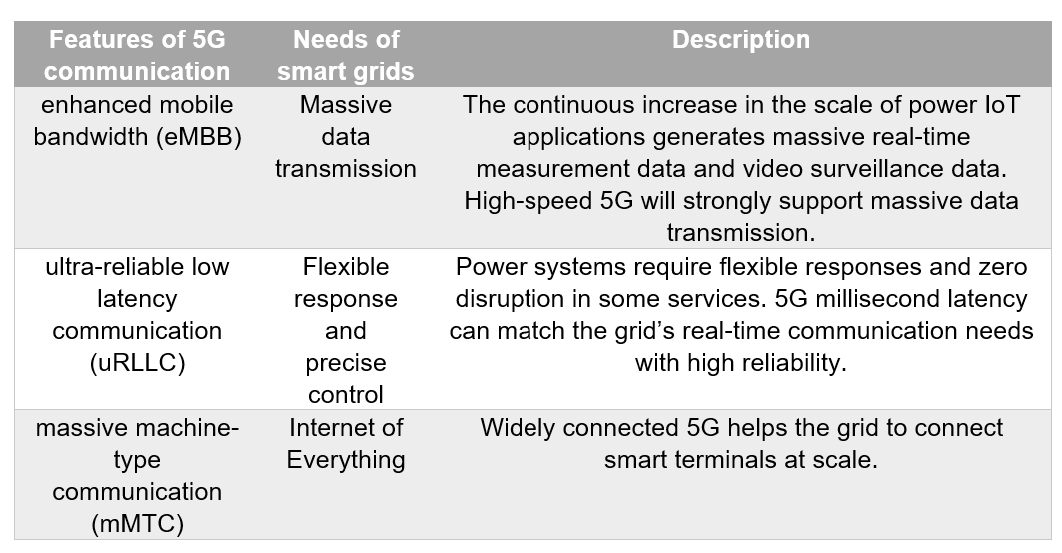Application of 5G Technology to Smart Grids
 |
 |
| Kunlun Gao | Yi Wang |
Introduction
To tackle the challenges of global warming, countries worldwide set ambitious goals to reduce carbon emissions in different industries. For example, the European Union (EU) and China aim to achieve carbon neutrality before 2050 and 2060, respectively. As a major carbon emitter, the power and energy industry plays a vital role in decarbonization. Nevertheless, decarbonization of power and energy systems needs to be underpinned by higher integration of renewable energy, which challenges the whole system’s reliability, stability, and flexibility. To address these challenges, a large volume of equipment and devices in all links of the power generation, transmission, transformation, distribution, storage, and consumption should be connected, monitored, and coordinated in real-time, which heavily depend on advanced information and communication technologies (ICT). Fifth-generation (5G) communication, as an emerging ICT, has been widely popularized in recent years and is becoming a core enabling technology in the future industrial Internet of Things (IoT). The industrial IoT in power and energy (i.e., Energy Internet) is no exception.
As shown in Table 1, the technical features of 5G communication are well aligned with the needs of future smart grids with high penetration of renewable energy.
Table 1 - 5G features highly compatible with smart grid performance

Although 5G applications are still in their infancy, they can still provide engineers and researchers in power and energy with huge room for imagination. Definitely, 5G technology will extensively contribute to the massive connections and monitoring, precise control, broadband communication, efficient computing, and secure communication of smart girds, as shown in Fig. 1. The first three range of applications listed abovedirectly correspond to three main features of 5G communication. The two main requirements of digitized and decentralized smart grids are efficient computing and secure communication, which 5G communication can facilitate.

Figure 1 - Potential applications of 5G communication in smart grids
For massive connections and monitoring, a large number of electrical devices are connected to smart grids. Their interconnection will bring unlimited potential for imagination to and beyond smart grids. For example, by connecting and coordinating all household appliances, the electricity consumption of buildings, communities, or even a certain region can be dynamically adjusted to accommodate distributed renewable energy. Mobile devices can also be connected with high reliability with 5G. The interconnection of electric vehicles not only contributes to smart cities and smart transportation but also helps the power system to accommodate distributed renewable energy through V2G charging stations. Although a large number of sensors have been installed, large volumes of data have to be discarded, and only the most basic information can be retained due to the communication burden. The lack of fine-grained information greatly restricts the practical application of big data analytics in smart grids. Increasing monitoring devices, such as micro-PMU, will be installed in the future. The diversified and large volume of data can be processed using 5G communication.
For precise control, take demand response as an example, with the help of 5G, dynamic demand response can be implemented in shorter time scales for frequency regulation in addition to only reducing the peak-to-valley difference on the demand side. Therefore, the uncertainties brought by the high penetration of renewable energy can be offset. In this context, coordinated control among massive power-consuming equipment needs low communication delay, while the less than 10ms communication delay of 5G can well meet the frequency regulation requirement. Fig. 2 presents a 5G-enabled load control system consisting of service terminals, demand response terminals, a communication network, and a master station system. In this case, the service terminal is connected to the building’s demand response terminal via a local network and then to the master station of the demand response system via a 5G communication network.

Figure 2 - 5G-enabled load control system
For broadband communication, collecting massive amounts of unstructured data, such as voice, image, and video, can help achieve a better situation awareness of distribution networks and provide better-personalized services for system operators and consumers. 5G communication efficiently enables this kind of voice, image, or video data in real-time. On this basis, different innovative businesses can be realized, such as virtual reality for power engineer training, intelligent inspection or even drone inspection of substations and power transmission lines.
For efficient computing, a large number of computing tasks, such as distributed machine learning (such as federated learning), distributed optimization (such as distributed optimal power flow), etc., should be implemented to ensure system security and stability. These tasks may suffer from high time and space complexity. 5G-enabled cloud computing and edge computing can ease the computational burden in the center and help the whole system operate in a distributed and robust way.
For secure communication, smart grids are inseparable from people’s production and life; thus, they should be operated in a secure environment. Public cellular networks are unreliable, while private cellular networks require colossal investment and operation costs. Network slicing in 5G communications is a promising solution to address these issues by providing smart grids with virtual private networks within shared public cellular networks.
We are pleased to see both the power industry and academia worldwide conducting research and practice related to 5G applications in smart grids. The EU Horizon 2020 supported Smart5Grid project plans to develop a 5G network platform customized for modern smart grids. It is expected that the project will be demonstrated with initiatives in four countries, Italy, Spain, Bulgaria, and Greece. The “5G Application Implementation Plan in the Energy Field” has been issued in China, suggesting accelerating the expansion of 5G application scenarios in smart grids and forming new models that can be replicated and promoted. There are already several demonstrative projects in China. Fig. 3 shows a demonstrative project of 5G in smart grids on campus in Shanghai, where six PMUs are deployed in a distribution grid with various distributed energy ressourses. The PMUs are connected to the 5G network through 5G Customer Premise Equipment (CPE) and are also connected to the power monitoring center. It is demonstrated that the 5G network can meet the communication requirements between the distribution PMU and the master station with an end-to-end delay of less than 15ms and a communication frequency of 100 frames per second.

Figure 3 - A demonstrative project of 5G in smart grids on campus in Shanghai
Even though the applications of 5G communication in smart grids are promising, many challenges, such as high energy consumption, coverage, resource allocation among different industries of 5G networks, should be fully addressed in the future. We believe it is time to gather experts from different countries to share their experiences and lesson in 5G applications in smart grids for a decarbonized future.
Working Group aim and scope
The WG D2.55 “Application of 5G Technology to Smart Grids” aims to provide timely reports on 5G applications in the power industry, including recommendations and best practices for related specifications and designs. Preliminarily, the WG will work on the following topics:
- The Developmental Trend of 5G Application in General Industrial Fields
- 5G Key Technologies
- Adaptability Analysis of 5G for Smart Grid Applications
- End to End Solution on Smart Grid 5G
- Typical Practices and Demonstrations on 5G in Smart Grid
- Prospect on Future Development of 5G in Smart Grid
The WG will coordinate such activities where appropriate with other CIGRE committees, subcommittees, and Working Groups, and will end by the end of 2023. We welcome and need the support from experts worldwide to contribute to the digital transformation and decarbonization of future smart grids.
